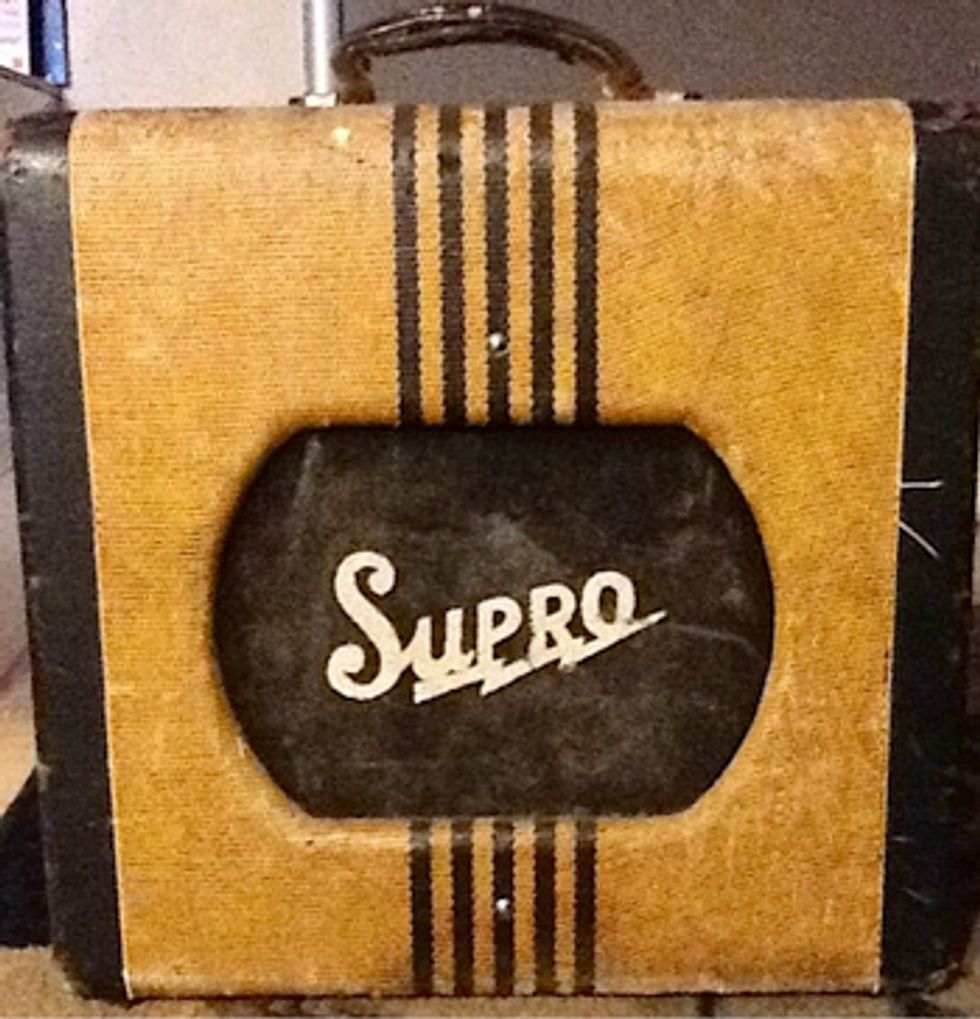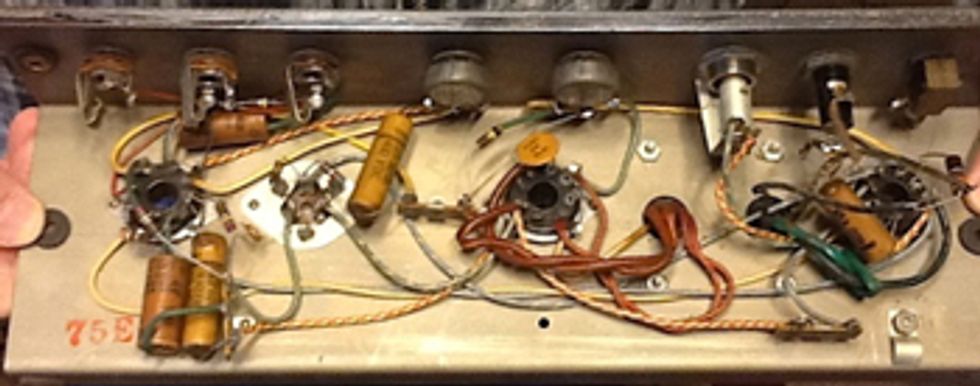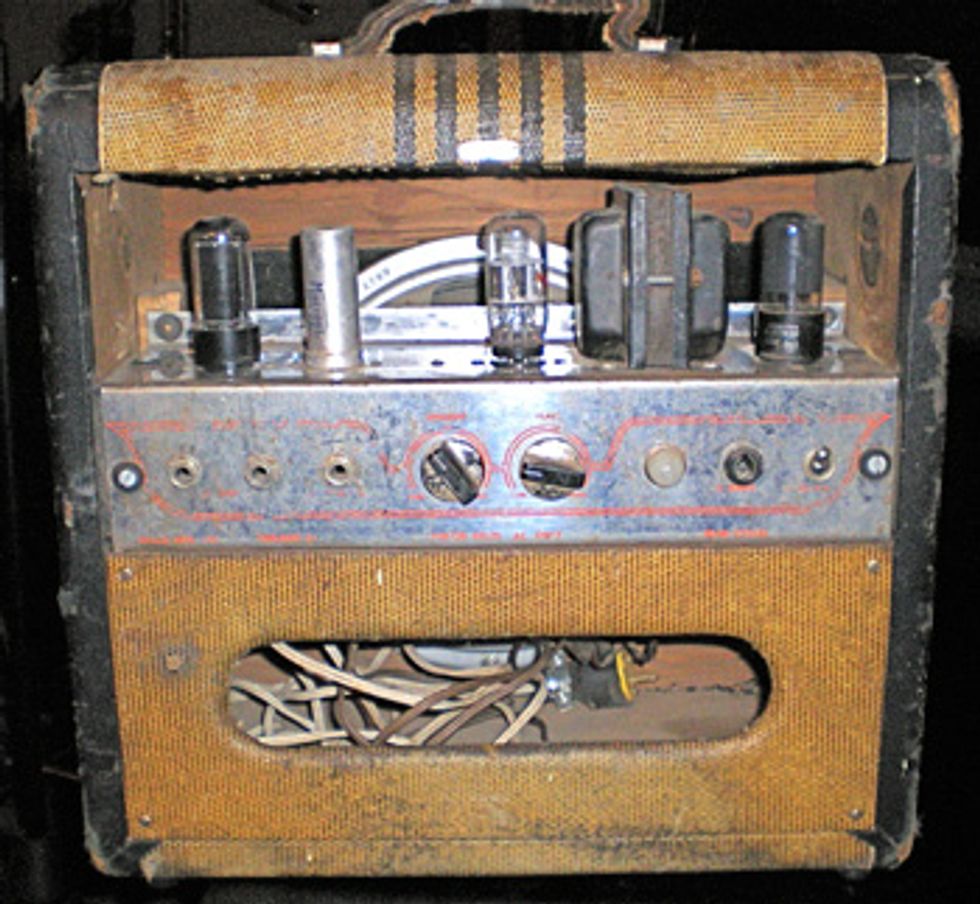
A sweet Supro 1x10 from the 1950s. These combos are prized by harp players, as well as guitarists and lap steel players looking for singing, low-wattage tube distortion.

Time capsule: This is how amps were wired by hand more than half a century ago.

The amp is powered by a single 6V6 and sports a 12AX7 preamp tube and a 5Y3 tube rectifier.
Hi Jeff,
Recently I was reading several of your
columns concerning old amps and caps
[“Bringing a Gibson Duo-Medalist
Back to Life, Parts 1 & 2” and “Dusting
Off a Pignose G40V” in the March,
April, and June 2011 issues].
Well, they struck a chord. I just got a ’50s Supro from a drummer friend. I assumed it was a Comet because of the look, but the schematics would point to a Spectator because the only schematics that fit this chassis are for a Spectator. [Our money says it’s a ’50s Supro Comet 1610 made by Valco of Chicago. —Editor]
My friend put this amp in a closet 30 years ago when it stopped working, and there it sat in the land of dust bunnies until I bought it. Someone had bypassed the fuse—crudely, I might add—but other than that, it all seems to be stock and everything looks fine. Should I rewire the fuse correctly and fire it up? (Maybe “fire it up” isn’t the best term to use here.)
I know a visual check only goes so
far. Because of the amp’s age, should I
remove all the caps and put them on a
tester before attempting to power it up?
Or perhaps you have another suggestion?
Thanks,
Mark
Hi Mark,
Since your question contains the phrases
“stopped working” and “someone bypassed
the fuse,” my initial thought is that worrying
about the state of the caps might be a
bit premature.
First, I would pull all the tubes (mark their positions, if necessary) and remove the chassis. After repairing the fuse holder and properly fusing the amp, plug the amp into a Variac or similar unit (quite a handy device in situations like this) and connect an AC voltmeter to the high-voltage output leads of the amplifier transformer. Turn the Variac’s output voltage to zero.
Now turn the amp on. Slowly raise the output voltage of the Variac and see if you measure any output from the Supro’s transformer. If you can raise the Variac to the 90V to 100V range and voltage is still present, the transformer may be okay.
Reduce the voltage to zero again and connect your meter to the 6.3V filament output of the transformer. Raise the Variac to approximately 100V and check for the presence of about 5-6 volts.
If this is also good, I would then drop the Variac to zero, substitute a solid-state rectifier for the rectifier tube, and once again slowly raise the voltage from the Variac, while monitoring the DC voltage on the main capacitor. Do this with the capacitors facing away from you in case one decides to vent. If you can raise this voltage to the 350V range or so, reduce the Variac voltage to zero, and remove the solid-state rectifier.
Now test all the tubes. If they’re good, reinstall them. If not, get replacements—either new ones or used tubes you can confirm are working. Now you’re ready to check the amp’s operation. With a little luck, the Supro may work, but you may still want to replace the filter caps in a unit that old, as there’s no telling how good they are or how long they’ll last.
Wishing you cool Supro tones!
Warning: All tube amplifiers contain lethal voltages. The most dangerous voltages are stored in electrolytic capacitors, even after the amp has been unplugged from the wall. Before you touch anything inside the amp chassis, it’s imperative that these capacitors are discharged. If you are unsure of this procedure, consult your local amp tech.
 Jeff Bober is one of
the godfathers of the
low-wattage amp revolution,
co-founded and was
the principal designer for
Budda Amplification. Jeff recently launched EAST
Amplification, and he can be reached at
pgampman@gmail.com.
Jeff Bober is one of
the godfathers of the
low-wattage amp revolution,
co-founded and was
the principal designer for
Budda Amplification. Jeff recently launched EAST
Amplification, and he can be reached at
pgampman@gmail.com.




![Rig Rundown: Russian Circles’ Mike Sullivan [2025]](https://www.premierguitar.com/media-library/youtube.jpg?id=62303631&width=1245&height=700&quality=70&coordinates=0%2C0%2C0%2C0)


























